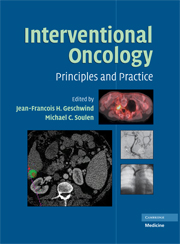Book contents
- Frontmatter
- Contents
- FOREWORD
- ACKNOWLEDGMENTS
- CONTRIBUTORS
- PART I PRINCIPLES OF ONCOLOGY
- PART II PRINCIPLES OF IMAGE-GUIDED THERAPIES
- PART III ORGAN-SPECIFIC CANCERS
- 9 Hepatocellular Carcinoma: Epidemiology, Pathology, Diagnosis and Screening
- 10 Staging Systems for Hepatocellular Carcinoma
- 11 Hepatocellular Carcinoma: Medical Management
- 12 Surgical Management (Resection)
- 13 Liver Transplantation for Hepatocellular Carcinoma
- 14 Image-guided Ablation of Hepatocellular Carcinoma
- 15 Embolization of Liver Tumors: Anatomy
- 16 Transcatheter Arterial Chemoembolization: Technique and Future Potential
- 17 New Concepts in Targeting and Imaging Liver Cancer
- 18 Intrahepatic Cholangiocarcinoma
- 19 Medical Management of Colorectal Liver Metastasis
- 20 Surgical Resection of Hepatic Metastases
- 21 Clinical Management of Patients with Colorectal Liver Metastasis Using Hepatic Arterial Infusion
- 22 Colorectal Metastases: Ablation
- 23 Colorectal Metastases: Chemoembolization
- 24 Radioembolization with 90Yttrium Microspheres for Colorectal Liver Metastases
- 25 Carcinoid and Related Neuroendocrine Tumors
- 26 Interventional Radiology for the Treatment of Liver Metastases from Neuroendocrine Tumors
- 27 Immunoembolization for Melanoma
- 28 Preoperative Portal Vein Embolization
- 29 Cancer of the Extrahepatic Bile Ducts and the Gallbladder: Surgical Management
- 30 Extrahepatic Biliary Cancer: High Dose Rate Brachytherapy and Photodynamic Therapy
- 31 Extrahepatic Biliary Cancer/Biliary Drainage
- 32 Surgical and Medical Treatment
- 33 Percutaneous Renal Ablation
- 34 Embolotherapy in the Management of Renal Cell Carcinoma
- 35 Epidemiology, Diagnosis, Staging and the Medical-Surgical Management of Lung Cancers
- 36 Image-guided Ablation in the Thorax
- 37 Interventional Treatment Methods for Unresectable Lung Tumors
- 38 Interventional Neuroradiology in Head and Neck Oncology
- 39 Percutaneous Ablation of Painful Metastases Involving Bone
- 40 Intra-arterial Therapy for Sarcomas
- 41 Prostate Cryoablation: A Role for the Radiologist in Treating Prostate Cancer?
- PART IV SPECIALIZED INTERVENTIONAL TECHNIQUES IN CANCER CARE
- INDEX
- Plate section
- References
24 - Radioembolization with 90Yttrium Microspheres for Colorectal Liver Metastases
from PART III - ORGAN-SPECIFIC CANCERS
Published online by Cambridge University Press: 18 May 2010
- Frontmatter
- Contents
- FOREWORD
- ACKNOWLEDGMENTS
- CONTRIBUTORS
- PART I PRINCIPLES OF ONCOLOGY
- PART II PRINCIPLES OF IMAGE-GUIDED THERAPIES
- PART III ORGAN-SPECIFIC CANCERS
- 9 Hepatocellular Carcinoma: Epidemiology, Pathology, Diagnosis and Screening
- 10 Staging Systems for Hepatocellular Carcinoma
- 11 Hepatocellular Carcinoma: Medical Management
- 12 Surgical Management (Resection)
- 13 Liver Transplantation for Hepatocellular Carcinoma
- 14 Image-guided Ablation of Hepatocellular Carcinoma
- 15 Embolization of Liver Tumors: Anatomy
- 16 Transcatheter Arterial Chemoembolization: Technique and Future Potential
- 17 New Concepts in Targeting and Imaging Liver Cancer
- 18 Intrahepatic Cholangiocarcinoma
- 19 Medical Management of Colorectal Liver Metastasis
- 20 Surgical Resection of Hepatic Metastases
- 21 Clinical Management of Patients with Colorectal Liver Metastasis Using Hepatic Arterial Infusion
- 22 Colorectal Metastases: Ablation
- 23 Colorectal Metastases: Chemoembolization
- 24 Radioembolization with 90Yttrium Microspheres for Colorectal Liver Metastases
- 25 Carcinoid and Related Neuroendocrine Tumors
- 26 Interventional Radiology for the Treatment of Liver Metastases from Neuroendocrine Tumors
- 27 Immunoembolization for Melanoma
- 28 Preoperative Portal Vein Embolization
- 29 Cancer of the Extrahepatic Bile Ducts and the Gallbladder: Surgical Management
- 30 Extrahepatic Biliary Cancer: High Dose Rate Brachytherapy and Photodynamic Therapy
- 31 Extrahepatic Biliary Cancer/Biliary Drainage
- 32 Surgical and Medical Treatment
- 33 Percutaneous Renal Ablation
- 34 Embolotherapy in the Management of Renal Cell Carcinoma
- 35 Epidemiology, Diagnosis, Staging and the Medical-Surgical Management of Lung Cancers
- 36 Image-guided Ablation in the Thorax
- 37 Interventional Treatment Methods for Unresectable Lung Tumors
- 38 Interventional Neuroradiology in Head and Neck Oncology
- 39 Percutaneous Ablation of Painful Metastases Involving Bone
- 40 Intra-arterial Therapy for Sarcomas
- 41 Prostate Cryoablation: A Role for the Radiologist in Treating Prostate Cancer?
- PART IV SPECIALIZED INTERVENTIONAL TECHNIQUES IN CANCER CARE
- INDEX
- Plate section
- References
Summary
90Yttrium (90Y) microspheres are 20- to 40-μ particles that emit beta radiation. Because the microspheres are delivered via the hepatic arterial route, the process can be considered “internal” rather than external radiation. The treatment algorithm is analogous to that followed with transarterial chemoembolization (TACE). Clinical history, physical examination, laboratory values and performance status are obtained. Patients are initially evaluated and staged using cross-sectional imaging techniques (computerized tomography [CT], magnetic resonance imaging [MRI], positron emission tomography [PET]). Once a patient is considered a possible candidate for therapy, evaluation using mesenteric angiography followed by treatment on a lobar basis is undertaken. Patients are followed clinically to assess toxicities and response prior to proceeding with treatment to the other lobe. A comprehensive review of the technical and methodological considerations in 90Y has been previously published (1–3).
Two devices are commercially available. Thera- Sphere (glass) was approved in 1999 by the Food and Drug Administration (FDA) under a Humanitarian Device Exemption (HDE) for the treatment of unresectable hepatocellular carcinoma (HCC) in patients with or without portal vein thrombosis who can have appropriately positioned hepatic arterial catheters (4). SIR-Spheres (resin) were granted full pre-marketing approval in 2002 by the FDA for the treatment of colorectal metastases in conjunction with intrahepatic floxuridine (FUDR) (5). Both devices have European approval for liver neoplasia and approvals in various Asian countries.
OVERVIEW
Patients with metastatic cancer to the liver from a colorectal primary tumor may be treated using surgical resection alone, providing a chance for long-term cure.
- Type
- Chapter
- Information
- Interventional OncologyPrinciples and Practice, pp. 280 - 289Publisher: Cambridge University PressPrint publication year: 2008



